9 Ways to Fix a Clogged Toilet (Quick & Easy)
-
- Last updated:
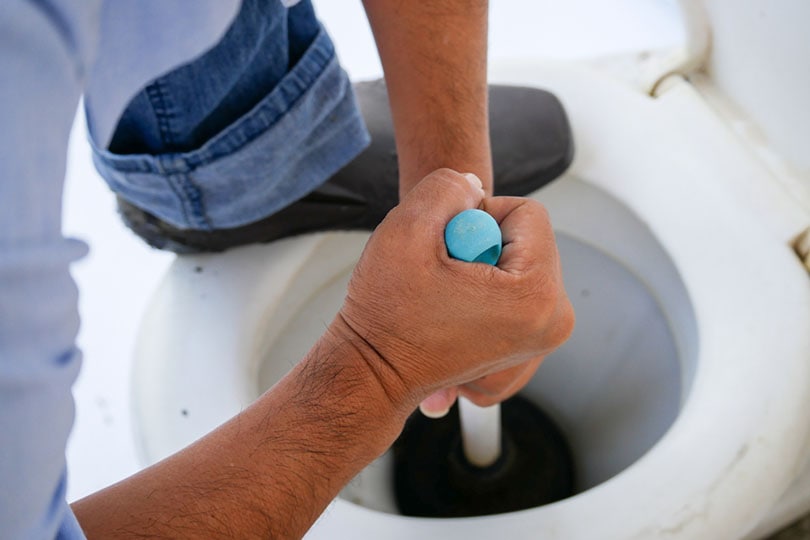
Join us while we discuss plunger types and methods, alternative solutions, and preventive steps to keep your toilet flushing properly.
Before You Get Started
With any luck, you’ll release the clog in a few minutes, but you should prepare for the worst and have a few supplies ready to go.
- Keep plenty of towels on hand to soak up any spills.
- A mop and mop bucket can be an effective way to clean up spills quickly
- A portable fan or dehumidifier can help dry up the area once you unclog the toilet.
- You probably want to change into some old clothes so you can dispose of them if things get messy
- We recommend wearing long rubber gloves. Eye protection is also a good idea.
- If a lot of water gets on the floor, you may also need rubber overshoes.
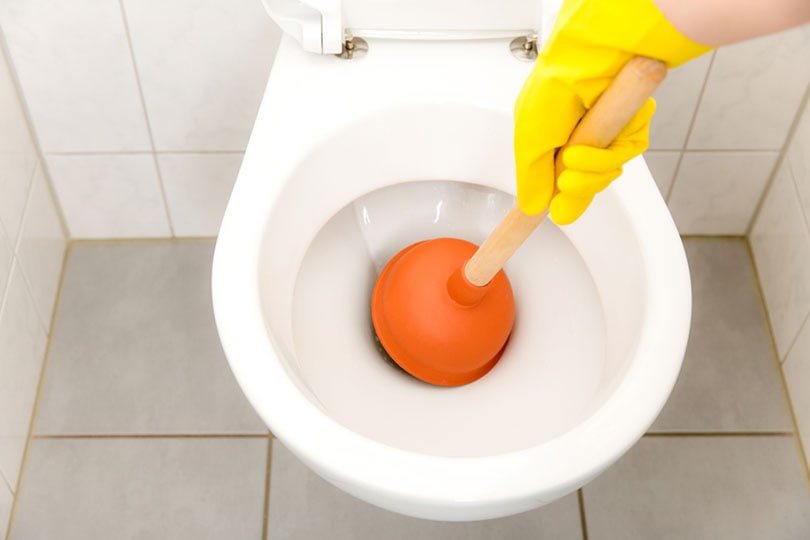
Unclogging the Toilet – Best Methods
Here are some things you can do to fix a clogged toilet.
1. Start with a Plunger
The best place to start is by using a plunger. It’s the best tool for the job, and quite often, it can remove the clog in under one minute.
Sink Plunger
There are several types of plungers, and the one most commonly seen is a sink plunger. The sink plunger has a wooden handle and a rubber cup-shaped plunging apparatus on one end. This type of plunger will do if it’s all you have, but it doesn’t have the correct shape to get a good seal on the toilet drain. For that, you needed a toilet plunger.
Toilet Plunger
The toilet plunger looks like a sink plunger, but the bell-shaped plunging apparatus has an extra piece that folds out and fits neatly into the toilet’s drain. The better seal created by the toilet plunger allows you to generate more force to release the clog.
Best Practices
To plunge your toilet, pull out the toilet plunger’s rubber flange and inserted it into the toilet’s drain hole. Push in and pull out quickly without breaking the seal between the plunger and the drain. Continue for several seconds until the clog works loose and the toilet flushes.
- You may need to make several attempts to work the clog loose.
- Don’t push too hard when there is air in the plunger, or it could splash.
- Make sure there is enough water in the bowl to cover the plunger.
2. Toilets Snake
If the toilet plunger is not successful, you may need to resort to using a toilet snake. You can purchase inexpensive models that may work or rent a more industrial-sized one from a local hardware store. The snake is a long wire with a coil hook to capture and remove debris in the drain. It often has a crank at one end so you can spin it as it makes its way into the drain.
To use the snake, turn the crank handle in a clockwise direction to feed it into the drain. When it stops turning, pull back slightly to hook the clog, then turn the crank handle in a counterclockwise direction to remove the clog from the pipe. Dispose of the debris and repeat until the toilet is running correctly.
Unclogging the Toilet – Alternative Methods
If the plunger didn’t work, or you don’t have one, there are a few alternative methods you can try to unclog your toilet. The water in your toilet is very cold and introducing warm water can break up grease and fats that can be clogging the drain.
3. Try Warm Water
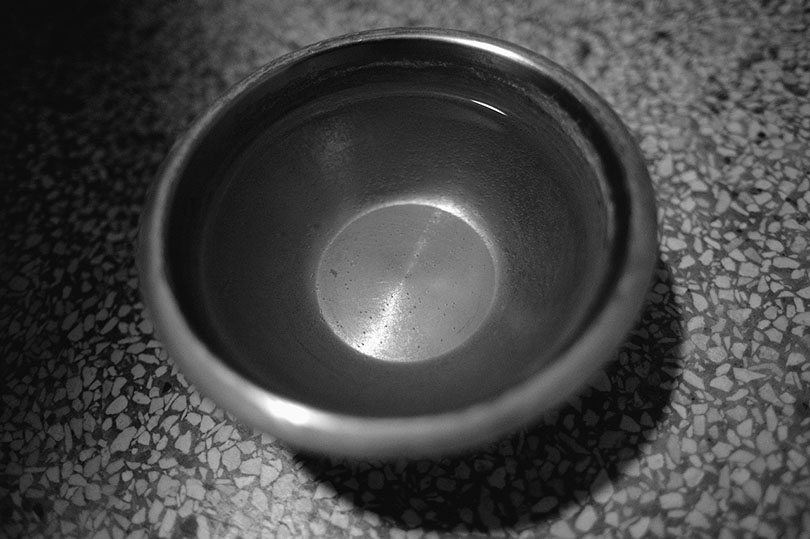
Warm water can work well to break up a tough clog, but using it is risky because it can melt the wax ring inside the toilet and leading to an even bigger problem. To try this method, heat 4 to 6 cups of water in a small saucepan until hot but not boiling. Then add the water to the toilet and let us in a few minutes to see if it works.
If it breaks up the clog, your good to go, but if you intend to give it another try, we recommend waiting at least 24 hours to allow temperatures to return to normal to avoid problems with the wax ring.
4. Dish Soap

Dish soap can be very effective in helping break up clogs. To try this method, dump the least 0.5-cup dish soap into your toilet bowl and allow it to sit a few minutes. Follow up with the pot of hot water as we did in the last step but remember not to use boiling water and only do it once per 24 hours. The dish soap can make the surface slippery enough that the clog moves out.
5. Vinegar and Baking Soda
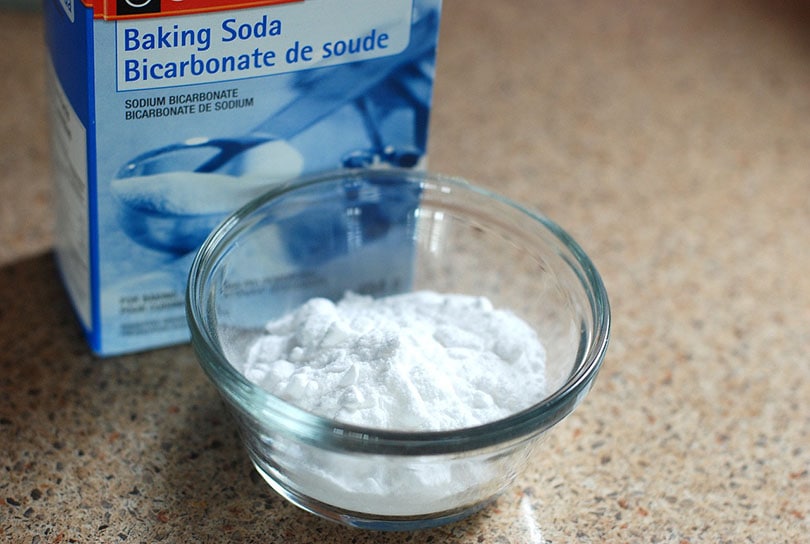
Combining vinegar and baking soda can give you the effervescent boost you need to push the clog through the drain and get the toilet working again. To use this method, pour 1 cup of baking soda into the bowl then 1 cup of vinegar. The fizzing action can break up the clog on its own, but you can help the process along by using the plunger.
The downside to this method is that it could cause water to spill out onto the floor if the ball is too full.
6. Use a Brush
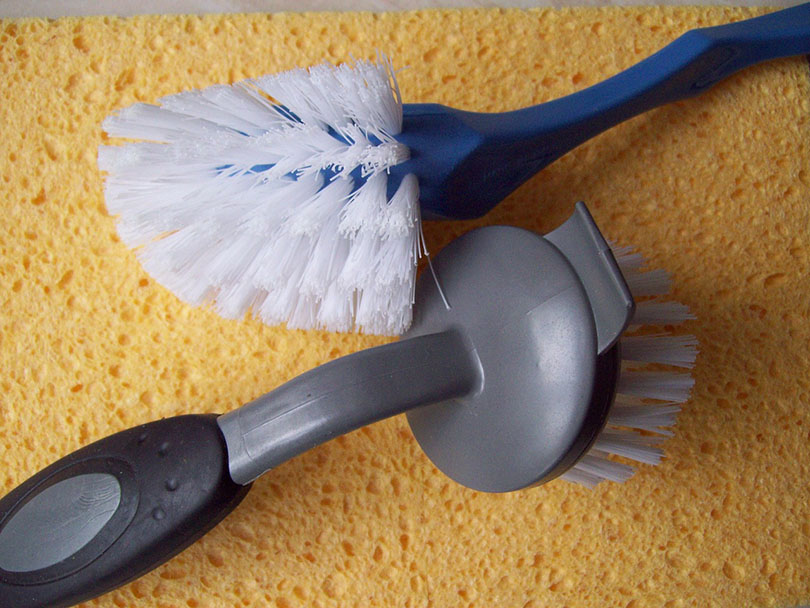
The brush technique is something you would only use if you didn’t have a plunger, and the idea is that you would use the toilet scrub brush in the same manner and hope it works. The larger brush may create enough suction to pull the clog loose and allow the toilet to operate correctly. You may also be able to get it in there better and push the clog from its seat. You will probably need a new toilet brush when you finish.
7. Try a Hanger

Here is another technique you would only try if you didn’t have the proper tool, in this case, a toilet snake. If you don’t have a snake on hand, you can try to unravel a metal hanger, wrap it in cloth, so you don’t scrape any surface, and use it to get into the drain to free the clog. We have been successful with this method many times, but it will require the long gloves we mentioned earlier.
8. Wet Dry Vac

You can use a wet-dry vacuum to drain water from the bowl and dislodge the clog. Some vacuums may get a good seal on the drain and be able to pull out the clog. The downside to this method is that it has the potential to get very messy.
9. Remove the Toilet
If none of the above steps work, the only alternative may be to remove the toilet to get to the problem’s root. If crayons or other foreign objects are blocking the drain, removing the toilet may be the only way to fix it. If you choose this option, you’ll need to replace the wax ring when you return the toilet to its original position.
Preventative steps
- Keep the lid down on your toilet. Doing so will prevent foreign objects from falling inside. Keeping a lid closed is especially important when you have children, but many people store stuff on the back of the toilet or a nearby shelf.
- You can regularly use an enzyme-based drain cleaner to help keep the drainpipe open, reducing clog risk. Enzyme Cleaners feed on organic matter, making them perfectly suited for the toilet drain, and they are not harmful chemicals. The bacteria are safe and biodegrade quickly. Most companies market enzyme cleaners to unclog drains, but they work better as a preventative measure and are far too slow to work in a critical situation like a backed-up toilet.
Conclusion
We recommend purchasing a toilet plunger and using that to unclog your toilet. As the old saying goes, use the right tool for the job. The toilet plunger can release 90% of all clogs with minimum effort or time spent. It only costs a few dollars and will last many years. Only if the plunge failed would we try the other methods, though we recommend regular treatments with enzymes.
We hope you have enjoyed reading over this short guide, and it has helped you get your toilet running smoothly again. If you have learned something new, please share this guide to fixing a clogged toilet on Facebook and Twitter.
Featured image credit: Ratchanee Sawasdijira, Shutterstock
Contents

